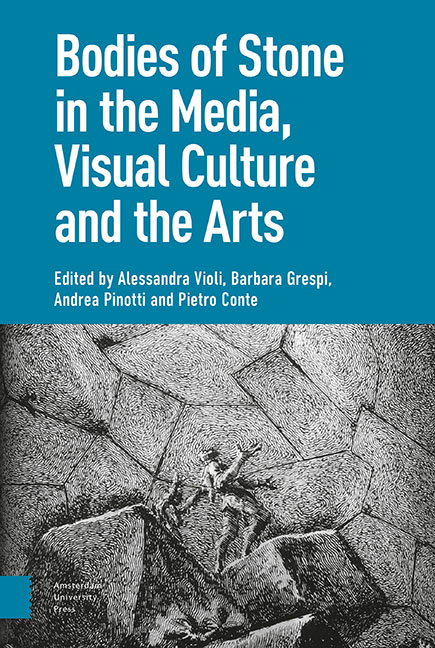Book contents
- Frontmatter
- Contents
- Introduction: Learning from Stone
- I Statue: The Imaginary of Uncertain Petrification
- 1 Theatre and Memory: The Body-as-Statue in Early Modern Culture
- 2 Translated Bodies: A ‘Cartographic’ Approach
- 3 Pantomime in Stone: Performance of the Pose and Animal Camouflage
- 4 Animated Statues and Petrified Bodies: A Journey Inside Fantasy Cinema
- 5 The Ephemeral Cathedral: Bodies of Stone and Configurations of Film
- II Matter: Size, Hardness, Duration
- 1 Bodies That Matter: Miniaturisation and the Origin(s) of ‘Art’
- 2 Brancusi’s ‘Sculpture for the Blind’
- 3 Cinema, Phenomenology and Hyperrealism
- 4 Ephemeral Bodies: The ‘Candles’ of Urs Fischer
- 5 The Celluloid and the Death Mask: Bazin’s and Eisenstein’s Image Anthropology
- III Corpse: Fossils, Auto-Icons, Revenants
- 1 Funeral Eulogy: Post-Mortem Figures and Redeemed Bodies, in Images
- 2 On Jack Torrance As a Fossil Form
- 3 Technical Images and the Transformation of Matter in Eighteenth-Century Tuscany
- 4 Glass, Mixed Media, Stone: The Bodily Stuffs of Suspended Animation
- 5 Bodies’ Strange Stories: Les Revenants and The Leftovers
- IV Monument: Embodying and Grafting
- 1 The Impassibly Fleshly, the Statue of the Impossible
- 2 Frozen into Allegory: Cleopatra’s Cultural Survival
- 3 The Orphan Image
- 4 The Well-Tempered Memorial: Abstraction, Anthropomorphism, Embodiment
- 5 Monuments of the Heart: Living Tombs and Organic Memories in Contemporary Culture
- Index
II - Matter: Size, Hardness, Duration
Published online by Cambridge University Press: 20 November 2020
- Frontmatter
- Contents
- Introduction: Learning from Stone
- I Statue: The Imaginary of Uncertain Petrification
- 1 Theatre and Memory: The Body-as-Statue in Early Modern Culture
- 2 Translated Bodies: A ‘Cartographic’ Approach
- 3 Pantomime in Stone: Performance of the Pose and Animal Camouflage
- 4 Animated Statues and Petrified Bodies: A Journey Inside Fantasy Cinema
- 5 The Ephemeral Cathedral: Bodies of Stone and Configurations of Film
- II Matter: Size, Hardness, Duration
- 1 Bodies That Matter: Miniaturisation and the Origin(s) of ‘Art’
- 2 Brancusi’s ‘Sculpture for the Blind’
- 3 Cinema, Phenomenology and Hyperrealism
- 4 Ephemeral Bodies: The ‘Candles’ of Urs Fischer
- 5 The Celluloid and the Death Mask: Bazin’s and Eisenstein’s Image Anthropology
- III Corpse: Fossils, Auto-Icons, Revenants
- 1 Funeral Eulogy: Post-Mortem Figures and Redeemed Bodies, in Images
- 2 On Jack Torrance As a Fossil Form
- 3 Technical Images and the Transformation of Matter in Eighteenth-Century Tuscany
- 4 Glass, Mixed Media, Stone: The Bodily Stuffs of Suspended Animation
- 5 Bodies’ Strange Stories: Les Revenants and The Leftovers
- IV Monument: Embodying and Grafting
- 1 The Impassibly Fleshly, the Statue of the Impossible
- 2 Frozen into Allegory: Cleopatra’s Cultural Survival
- 3 The Orphan Image
- 4 The Well-Tempered Memorial: Abstraction, Anthropomorphism, Embodiment
- 5 Monuments of the Heart: Living Tombs and Organic Memories in Contemporary Culture
- Index
Summary
This section focuses on ‘petrified’ bodies understood from the perspective of their material agency. How do qualities such as bulk, hardness and durability impact upon the experiencer? And in what ways can these physical properties be challenged, modified or even radically altered so as to transform an inanimate artefact into an ‘animated’ body? What strategies can be pursued to make an object be regarded as an active agent? These questions obviously do not imply a recrudescence of animistic visions: objects are not considered as endowed with any sort of intentionalagency or consciousinfluence but rather with the intrinsic ability to affect—thanks to their materiality—anyone who happens to relate to them. All the essays collected in this section deal with this affective power of the animated ‘stone’ bodies.
As many recent studies in the field of ethology and evolutionary aesthetics have shown, Homo sapiens’ aesthetic behaviour is deeply rooted in the multifarious processes of so-called ‘artification’, a specifically human disposition to intensify and deliberately make an object salient through the intentional manipulation of its ordinary features. By way of artification, mere matter comes to be invested with powers that far exceed its physicality: a whole sphere of possible meanings supervenes upon the domain of matter and its qualities. Consequently, things are transformed into cultural objects and acquire the ability to affect human perception—and, in turn, understanding—of the world. In this sense, the notion of agency, traditionally understood to denote an epistemic capacity of solely human subjects, can also be applied to artified objects and material-cultural phenomena.
Within this general framework, one has to reflect on what kind of power specificmaterials possess and how they impact differently on the observer depending on their specificphysical properties. As famously pointed out by Ernst Gombrich in Art and Illusion, a marble or bronze bust will, for instance, never look like a head cut off, but the very same bust, if only modelled in wax, will convey precisely that impression (and the uncanny feeling associated with it). The following essays, therefore, focus on different materials with the aim of shedding light on their different agencies and, more precisely, on the various ways they can be exploited in order to produce a veritable animation of the inanimate.
- Type
- Chapter
- Information
- Bodies of Stone in the Media, Visual Culture and the Arts , pp. 127 - 132Publisher: Amsterdam University PressPrint publication year: 2020

